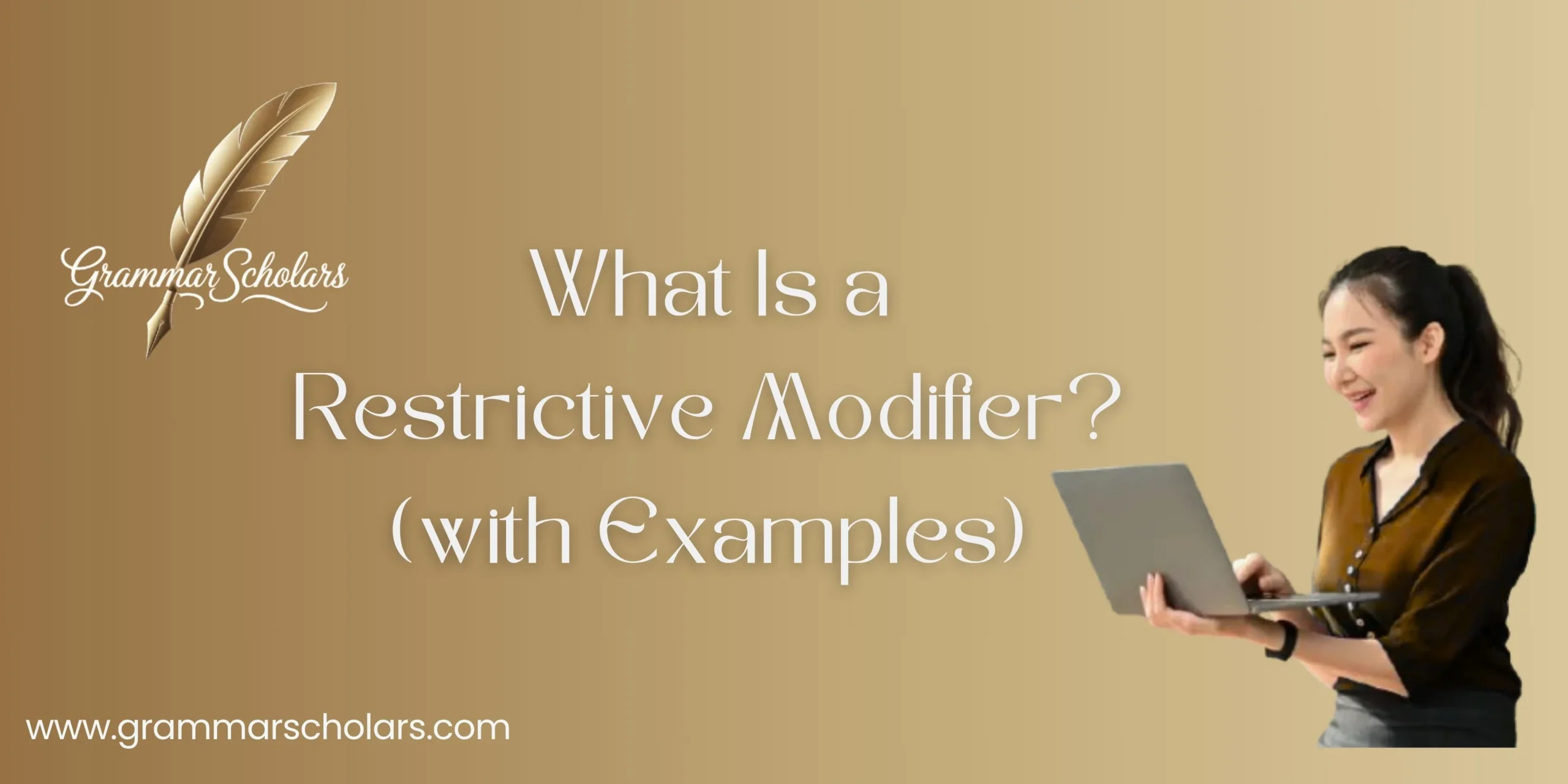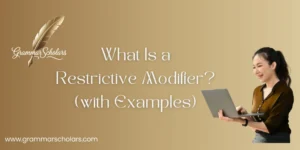In English grammar, restrictive modifiers are like a secret sauce, shaping sentences by highlighting essential details. They act as gatekeepers, ensuring only the most important information remains, so the reader doesn’t drown in extra words. Without them, stories and descriptions can feel vague, making it hard to identify main characters or follow the point. If you’re wondering, What Is a Restrictive Modifier? (with Examples), Think of it as the tool that keeps sentences focused and your writing sharp.
From teaching English, I’ve seen how well-crafted restrictive clauses make reading smoother by giving every sentence balance and clarity. They simplify even complex ideas, turning scattered thoughts into a cohesive flow.
By keeping writing structured and easy to follow, they make your content engaging and precise, ensuring the reader grasps the meaning without confusion.
Writing matters- especially when you want to make sure your audience understands you. A restrictive modifier holds the key to tightening meaning, avoiding confusion, and making your writing sharper. This guide dives deep into what restrictive modifiers really are, how they differ from nonrestrictive ones, how to use them effectively, and how to avoid common pitfalls. Let’s get into it.
Introduction
Ever read a sentence and thought, “Wait… who exactly are they talking about?” That’s often because a restrictive modifier is missing- or used incorrectly. These little words and phrases zero in on what we mean. Drop them in just right, and your meaning becomes crystal clear. Slip them in wrong, and everything turns muddy.
In this post, we’ll:
- Explain what restrictive modifiers are and why they matter
- Compare restrictive vs. nonrestrictive modifiers
- Break down punctuation rules and pitfalls
- Explore advanced use with adjective/adverbial modifiers
- Walk through real-world examples and mini case studies
- Provide practice exercises so you can test yourself
By the end, you’ll know exactly how to spot and deploy restrictive modifiers- and when to skip them.
What Is a Restrictive Modifier?
A restrictive modifier defines or limits the noun or phrase it describes- without it, the sentence’s meaning shifts.
Plain English definition: A restrictive modifier restricts meaning by specifying which one, when, or how many.
Example:
I want the blue pen.
Here, blue restricts ‘pen’ to just one color. Drop it, and you open up to all pens.
Why it matters
- Precision: “The students who studied passed.” Without “who studied,” you’d assume all students passed- even ones who didn’t.
- Clarity: Details narrow focus.
- Correct meaning: Restrictive modifiers can change who or what we’re talking about.
Quick distinction:
| Sentence | Modifier | Meaning without modifier | With modifier |
| “Read the book on the desk.” | on the desk | Any book | Specifically, the book is located on the desk |
| “Books that inspire me are rare.” | that inspire me | Any books | Only books which inspire me |
Restrictive vs. Nonrestrictive Modifiers
Comparing both helps lock in when commas matter and when they don’t.
Restrictive Modifier
- No commas
- Identifies which one
- Changes the noun’s meaning
Nonrestrictive Modifier
- Uses commas
- Adds extra info
- Doesn’t define or limit meaning
Side-by-side examples:
- Restrictive: “Cars that run on electricity are eco‑friendly.” (Only electric cars)
- Nonrestrictive: “Hyundai Ioniq, which runs on electricity, is eco‑friendly.” (Extra info about the car)
Table: Restrictive vs. Nonrestrictive
| Feature | Restrictive Modifier | Nonrestrictive Modifier |
| Commas | ✗ No commas | ✔️ With commas |
| Function | Restricts meaning (“which one”) | Adds extra info (“by the way”) |
| Removes meaning? | Yes, changes reference | No, stays about the same object |
Common Types of Restrictive Modifiers
You’ll encounter various types. Here’s a breakdown with examples:
Adjective Clauses
Introduced by that, who, which (with no comma). They define limiting information.
- Example: “The writer who won the award is 34.”
- You specify one writer- the award winner.
Adverbial Phrases
These restrict how or where an action occurs.
- Example: “Students studying at night did best.”
- Only those studying at night performed best.
Single-word Ambassadors
Single words working as restrictive modifiers already pinpoint the subject.
- Example: “I need fresh oranges.”
- Only fresh ones, not old or processed.
How Restrictive Modifiers Improve Clarity
Ambiguous: “We’ll meet at the gate.”
Clear with restriction:
- “We’ll meet at Gate 3.”
- “We’ll meet at the airport gate.”
Animals listed in a zoo
- “Lions that live in Africa are majestic.” (All lions in Africa)
- Drop the modifier and you potentially talk about all lions- even those in Asia.
📌 Key takeaway: Restrictive modifiers guide the reader to a specific subject or action- reducing ambiguity and sharpening communication.
Punctuation Rules for Restrictive Modifiers
No comma = Restrictive.
Comma = Nonrestrictive.
Common mistakes:
- Wrong: “The students, who studied last night, passed.”
- Mistake: all students passed- but you only meant some.
- Fix: “The students who studied last night passed.”
Quick-Reference Table
| Rule | Example | Why |
| No commas when restricting meaning | “The cars that use diesel are older.” | Refers only to diesel cars |
| Use commas for adding extra info | “My car, which I bought last year, runs smoothly.” | I’m not defining the car, just adding a comment |
Common Errors with Modifiers
Missteps can muddle meaning quickly. Let’s pinpoint two big ones:
Misplaced Modifiers
Put them in the right spot- or meaning shifts.
- Wrong: “She almost drove her kids to school every day.”
- Does “almost” belong to “drove” or “every day”?
- Better: “She drove her kids to school almost every day.”
Dangling Modifiers
No clear subject, so the sentence misfires.
- Wrong: “While driving to work, the radio played loudly.”
- Sounds like the radio was driving.
- Better: “While driving to work, I heard the radio playing loudly.”
✔️ Self-edit checklist:
- Ensure each modifier sits next to what it’s modifying
- Remove or rewrite dangling/ambiguous modifiers
- Reread aloud and check flow
Advanced Usage
Restrictive Adjective Phrases vs. Full Clauses
- Phrase: “The house built in 1890 looks charming.”
- Clause: “The house that was built in 1890 looks charming.”
Both specify which house- but one’s shorter. In tight writing, keep it concise.
Restrictive Adverbs
- “Call me when you arrive.”
- When you arrive, restrict call.
Avoid stuffing too many modifiers, or your sentence will burst with awkwardness.
- When you arrive, restrict call.
Practice Exercises
Mark whether the modifier is restrictive or nonrestrictive:
- “The artist who painted this mural is famous.”
- “Paris, which I visited last year, is lovely.”
- “Drivers who don’t wear seat belts risk injury.”
- “My laptop, which I bought in 2022, still works fine.”
- “Shakespeare plays that feature magic feel timeless.”
➡️ Answer key with explanations available at the end.
Final Thoughts
Mastering restrictive modifiers isn’t just about polishing grammar; it’s about shaping sentences that deliver precision and clarity every time. When you use these modifiers correctly, your reader knows exactly who or what you’re talking about, without confusion or misinterpretation. Misplacing or overusing commas, however, can quickly twist your meaning, making your writing vague or misleading.
Think of restrictive modifiers as spotlights. They zero in on the exact details that matter, helping you eliminate unnecessary noise. Whether it’s an adjective clause defining a specific person or a single descriptive word narrowing a category, these elements make your communication sharper and more trustworthy.
In professional contexts like legal writing, journalism, and academic work, the difference between restrictive and nonrestrictive modifiers can drastically change the meaning of a sentence. For example, omitting or misplacing a modifier can shift liability in a legal document or distort a news report.
Consistently applying these rules builds reader trust, strengthens your writing voice, and ensures your content stands out online. Combine precise modifiers with correct punctuation, and your sentences will flow naturally- just like a skilled writer intended.
FAQs
How can I quickly tell if a modifier is restrictive?
Remove the modifier from the sentence. If the meaning changes or becomes vague, it’s restrictive. Restrictive modifiers define the subject directly, while nonrestrictive ones simply add extra information.
Do restrictive modifiers ever need commas?
No. Restrictive modifiers never take commas because they’re essential to the sentence’s meaning. Adding commas can turn them into nonrestrictive modifiers, which may change the meaning entirely.
Can a single adjective be a restrictive modifier?
Yes. Words like red, fresh, or only can function as restrictive modifiers. They narrow the noun they modify, specifying exactly which one is meant.
What’s the easiest way to fix dangling modifiers?
Make sure the modifier connects to the subject doing the action. Add or rearrange words so the sentence makes logical sense and flows naturally.
Are restrictive modifiers important outside of formal writing?
Absolutely. Even in casual emails, marketing, or storytelling, restrictive modifiers keep your meaning sharp and prevent confusion, improving readability and engagement.











